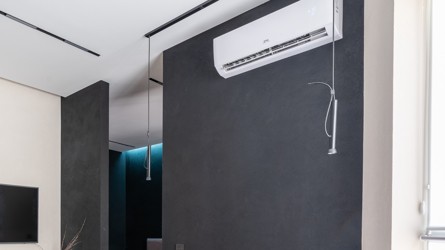One of the essential things to do before buying air conditioners is to compare mini splits vs. central air conditioners. These air conditioning units have different characteristics, and they function differently.
A mini split is a ductless AC whose indoor units can adjust to different temperatures, which is very unlike the traditional conditioner that requires you to turn it on and off.
On the other hand, a central air conditioner uses ducts and vents to circulate cool air in the home. In addition, it has an outdoor unit to capture outdoor air and purify it, then circulate it in the house.
Before comparing the mini splits and central air conditioning, this article will first explain how these two work. Afterward, we will state the things to look at when comparing central AC vs. mini split.
Understanding How Mini Split Works
A mini split is a ductless air conditioner for heating and cooling the home. The AC has many small indoor units that you can set to different temperatures. The mini split AC does not have large ducts like the traditional ACs but runs on a few tiny lines.
Mini-splits are more efficient than traditional air conditioners. When put in cooling mode, the unit removes heat from inside the house to outside. It has separate air handlers to blow cool air into the home so that you can set the rooms at different temperatures.
The indoor units of the mini split system are easy and convenient to mount. Since they require thin tubes and cable connection, you can mount them on the walls. You can also get floor-mounted units, floor standing, or ceiling suspenders. The ceiling suspenders offer more airflow but are noisy.
Homeowners choose mini split units over other types because these offer individual control of each indoor unit. They are also energy efficient, have a humidifier, and provide high-quality air.
How Does Central Air Conditioning Work?
The central air conditioning heats and cools the home from a central location. The system collects air from the rooms, cools and dehumidifies it, and then blows it back into the rooms through the supply air registers.
Unlike the mini splits, a central air conditioning system has significant components, like the fans for pulling air through the system. It also has a compressor, evaporator, and refrigerant lines.
The central air conditioning draws the home’s warm air through the ductwork using a furnace. The drawn air blows across the evaporator coil, which removes heat to cool it down.
The refrigerant in the coil absorbs the heat and is pumped to the condenser. A condenser is found in the outdoor air cooling unit. The heat in the condenser is expelled outside, and the refrigerant cools down and returns to the coil inside the home to cool the warm air.
The benefit homeowners get from central air conditioning is cooling in all rooms. You don’t need to select temperatures for specific rooms. This air conditioning unit is also cost-effective. However, you need a specialist to install the ductwork.
Factors to Consider When Choosing Split AC vs. Central AC
Now that you understand how mini-split and central air conditioning work, you can easily select one that suits your needs. When buying, compare the pros and cons of these air conditioners and choose the one with more pros.
Some factors to consider when purchasing the ac units are:
1. The Efficiency of the Units and Their Operations
While most homeowners hurry to compare the different units’ prices, checking the operation is more critical. The heating and cooling capabilities determine the unit’s efficiency.
The central AC uses ducts to control the home’s temperatures. The unit relies on the furnace, which pulls in warm air and cools it in the refrigerant. The furnace is a prominent device installed outside the home, and it can keep your home warm even when the temperatures are too low.
On the other hand, mini splits have a heat pump that cools and heats the air depending on the set temperatures. These are ideal for homes without ductwork and are energy efficient.
2. Cost of the Units
Although the cost of mini split vs. central air should not be the first thing you check in an AC, it can be the second. This is because mini-splits are cheaper than central air conditioning. They cost between $2000 and $14500 while central air costs between $3700 and $7400.
Besides, central ACs are hard to install, costing more labor. These units require ducts to run, which is another expense. Mini-splits are easy to install because they are ductless. You can DIY the installation if you have the expertise.
3. Power Consumption
Energy bills could increase depending on your air cooling system. Some factors that determine your unit’s energy consumption are the capacity of the AC unit, the SEER rating, and how much you use the unit.
The SEER rating is an essential factor when comparing the energy consumption of these two units. Mini-splits have a higher SEER rating consuming less power than the central AC units. The central AC can consume 3500 watts in an hour, higher than the 2000 watts mini splits consume.
4. Longevity
Air conditioners are expensive, and replacing them can be costly. Therefore, you need a device that will last longer with fewer maintenance costs. Although the mini split is cheaper, it has a shorter lifespan. These air-cooling units last between 15 to 20 years.
The central air conditioning lasts between 20 and 25 years, which is five years longer than the mini split’s lifespan. Although this is an attractive feature, ensure you consider other factors.
5. Aesthetics
If you value the aesthetics of your devices, this is an essential factor when choosing mini splits vs. central air. The mini splits have evaporators that you install on the interior walls or doors. These can tamper with your indoor aesthetics.
The central air systems are cool and invisible. You can install them in hard-to-spot places in the living room. These are better options if you want to maintain your home’s interior aesthetics.
Final Words
Once you know what to consider when choosing between mini splits vs. central air, the buying process will be smoother. It is hard to tell the best unit to choose because they have various pros and cons. The central air is your go-to option if you want a device that lasts longer and maintains your aesthetics. Let the Hurliman help you install your AC unit; whether it’s a mini split or central air setup, we’ve got the expertise to do the job right.






